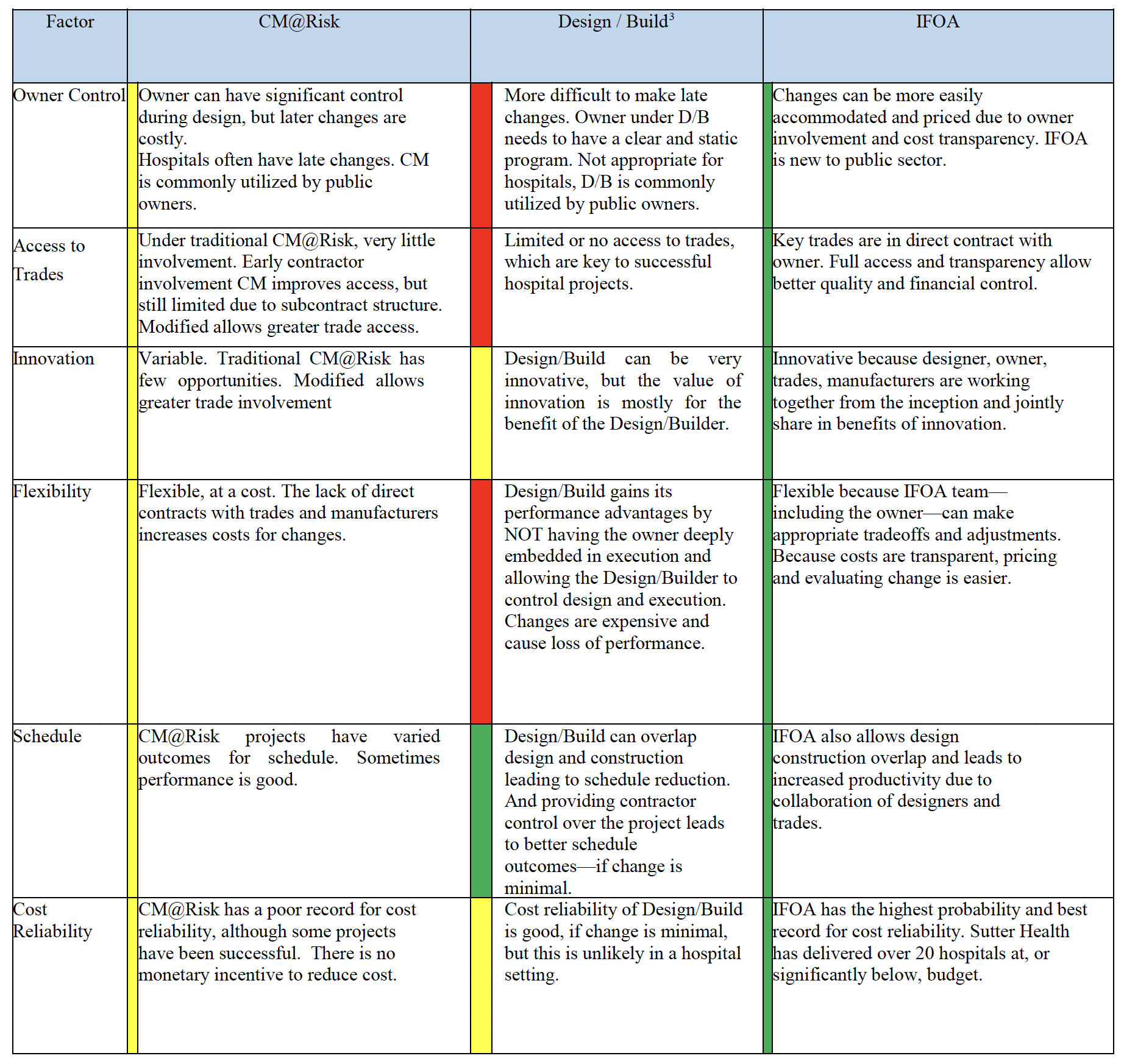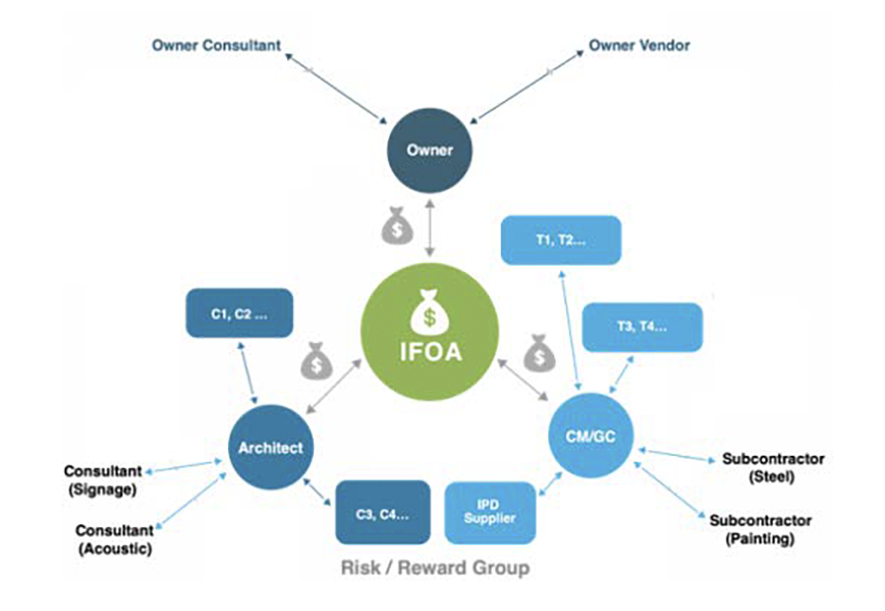Procurement Example: Integrated Project Delivery
UCSF Helen Diller Medical Center at Parnassus Heights
UCSF is utilizing the Integrated Project Delivery method to complete the New Hospital at Parnassus Heights Program using the Integrated Form of Agreement (IFOA). The design and construction planning is currently being performed by an integrated team including UCSF, the architect, the general contractor, and key trades working collaboratively on-site in a “big room” environment, also referred to as the Integrated Center for Design & Construction (ICDC), to optimize Program quality within a cost target set by UCSF.
Project Details
900,000 square feet
15 levels
366 beds
Multiple structures
$1.0 – $1.5 Billion
Background
Currently, patient care at the Parnassus Heights campus is provided in two iconic buildings: Moffitt and Long Hospitals and Medical Building 1, known as the Ambulatory Care Center. Built in 1955, according to state law, Moffitt Hospital must either be decommissioned for inpatient care or upgraded by 2030 to meet seismic codes. The 2014 long-range development plan by UCSF envisioned a new hospital on a different site.
Hospital projects, particularly large ones, are highly challenging. They require balancing numerous factors, such as patient and staff well-being, operational efficiency, sustainability, cost, and schedule. These buildings are filled with specialized equipment and must comply with strict regulations from bodies like OSHPD and DHS, in addition to meeting building and planning codes.
Comparison of Delivery Options
The campus evaluated delivery models for this project, assuming a ten-year complex healthcare program, focusing on:
Cost and Schedule Reliability: Ensuring on-schedule, within-budget delivery of facilities.
Owner Control: Maximizing UCSF Health Major Capital Project’s capacity to meet specific facility and operational needs and the defined Program Objectives.
Flexibility: Allowing for adjustments based on changing business needs and medical technology.
Access to Trades: Giving UC direct access to the trades' knowledge, communication, and expertise.
Incentive Compensation Layer: Encouraging innovation and aligning interests by pooling non-UC Program Risk/Reward Participants’ profits in a risk buffer that fluctuates based on program outcomes. This buffer safeguards against overruns, promoting efficient performance while extending the range of successful outcomes.
Innovation: Enhancing incentive for creativity among program participants to leverage cross-functional design and construction teams' innovative potential.
Change Orders: Preventing UC-incurred change orders due to coordination and design errors through contractual limits.
Claims: Minimizing UC's risk and potential claims through contractual limitations.
Three delivery strategies were considered for the UCSF Helen Diller Medical Center at Parnassus Heights Program:
I. Design Build Contract
II. Construction Manager at Risk Contract
III. Integrated Form of Agreement
Howard W. Ashcraft, Jr. from Hanson Bridgett LP prepared this analysis of project delivery approaches for major, complex healthcare programs.
The chosen delivery model ensures cost-effectiveness and prevents favoritism and corruption. Clear visibility in subcontracting, transparent and collective contingency funds, and decision-making processes during construction will safeguard the University’s interests and public funds.
The proposed Integrated Form of Agreement (IFOA) delivery model offers several advantages for UCSF, such as:
Better outcomes than the UCSF Mission Bay Hospital Construction Manager at Risk Model, thanks to insights gained from earlier projects and experience since 2010
Increased interest from the industry, enhancing the probability of engaging top-tier teams within the competitive Bay Area market
Enhanced budget control, operational efficiency, and transparency through direct interactions with subcontractors, consultants, and vendors
Promotion of shared objectives over individual ones by distributing profit margins
The incentive for cost-effective management through a shared profit model provides a buffer against potential budget exceedances.
Lowered risk of obligatory change orders and claims due to contractual agreements
An environment that encourages innovation through its structure and business approach
In-depth involvement of owners in decision-making processes
Improved predictability in terms of cost, timeline, and quality
IFOA Contract Structure
Solicitation Activities
1. Master Planning and Functional and Space Programming: Led by an architectural firm with support from key engineering firms.
2. Design Consultants - Architectural and Engineering Services:
Design Firm: A local architectural firm partnering with a globally recognized design firm for project validation, schematic design, design development, creation of implementation documents, and overseeing construction.
Key Professional Disciplines: Mechanical, Electrical, Plumbing, Structural, Civil, Landscape Design, Exterior Wind, Low Voltage, Audio Visual, Security, Transportation and Circulation, Interior and Exterior Signage, Vibration/Sound Transmission, LEED Consulting, Medical Equipment Planning, Laboratory Planning, Kitchen Equipment Planning, and Code/Life Safety Review
Other Disciplines: Fire Alarm, Building Management System (BMS), Elevators, Automatic Fire Sprinkler, Pneumatic Tube, and Exterior Skin Systems
3. Construction Team: A collaboration among three general contractors.
4. Subcontractors/Trades


